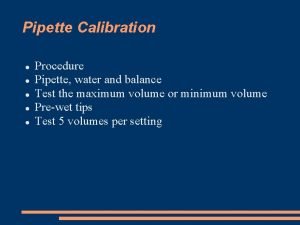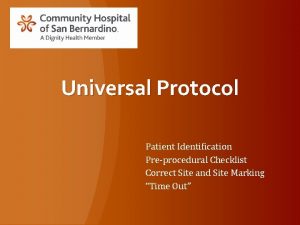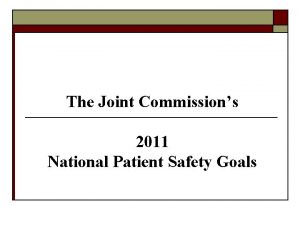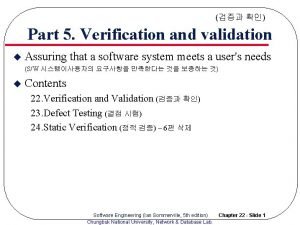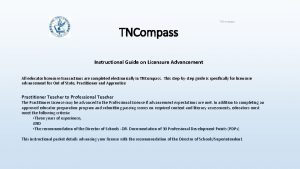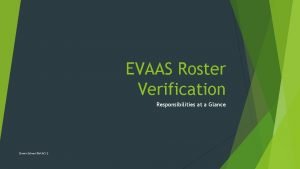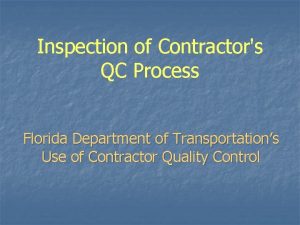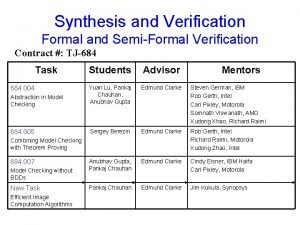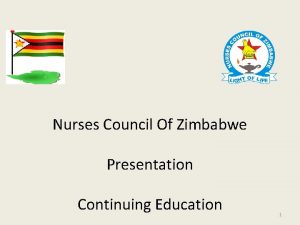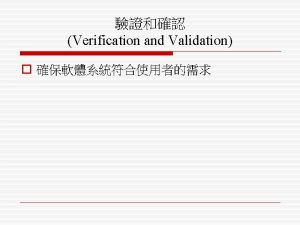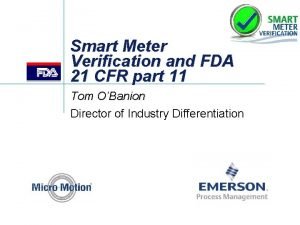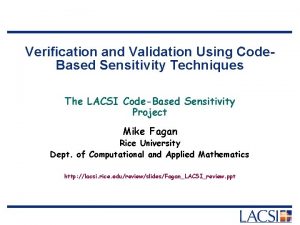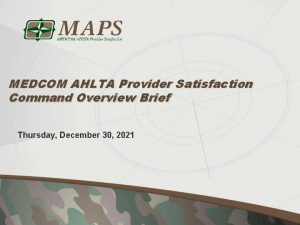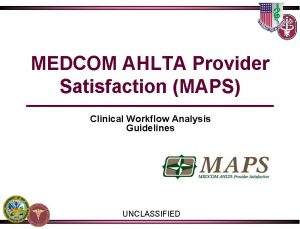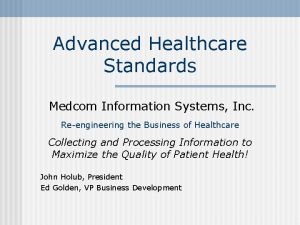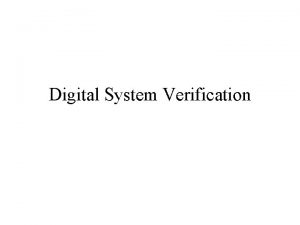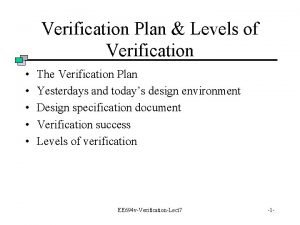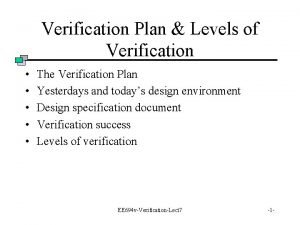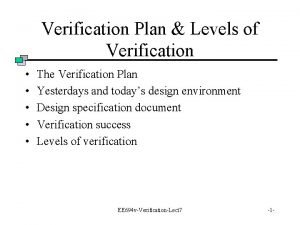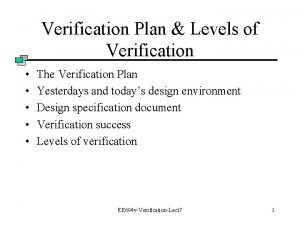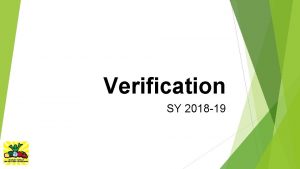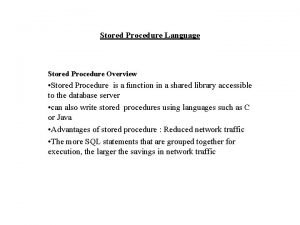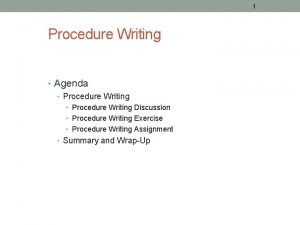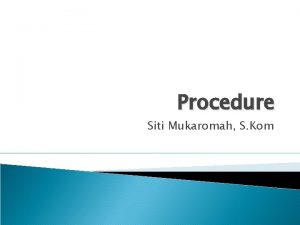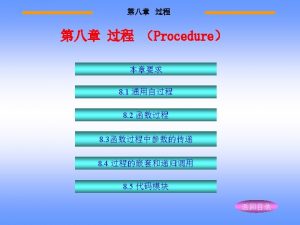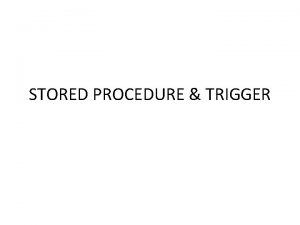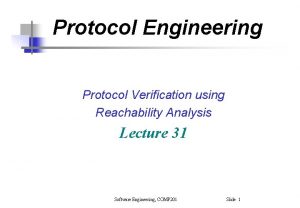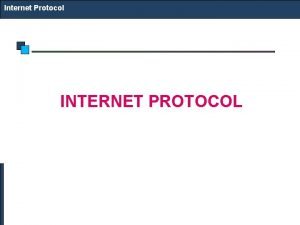MEDCOM Regulation 40 54 Universal Protocol Procedure Verification






















- Slides: 22

MEDCOM Regulation 40 -54 Universal Protocol: Procedure Verification Policy

Policy Update Surgeries and procedures performed on the wrong patient or wrong side/level/site continue to be a part of our Patient Safety Culture. MEDCOM Regulation 40 -54 replaces MEDCOM Circular 40 -17 Documentation: MEDCOM Form 741 Universal Protocol: Procedure Verification Checklist and MEDCOM Form 741 -1 Non_OR Procedure Verification Checklist The Joint Commission (TJC) Universal Protocol (June 2008) is incorporated into Reg 40 -54.

Everyone is responsible! Safe Surgery/Procedural Care is more than Checking the box Redundancy at critical points is to ensure the correct procedure at the correct body site is performed on the correct patient.

TJC Universal Protocol 1. Pre-procedural verification process. UP 01. 01 2. Mark procedural site - UP 01. 02. 01 3. Time-Out - UP 01. 03. 01

Pre-Procedural Process Verification of the correct person, correct surgery, and correct procedure occurs: a. At the time the procedure is scheduled b. At the time of preadmission testing and assessment c. At the time of admission or entry into the facility for a procedure d. Before the patient leaves the pre-procedure area or enters the procedure room e. Anytime responsibility for care is transfered

Who should verify? All are responsible for checking Licensed personnel are responsible for checking and documenting on MEDCOM Form 741 for all OR procedures; 741 -1 for minimally invasive procedures conducted in clinics

When to verify? Pre-Procedural Area UP 1. 01 Clinical Staff verifies patient identity and consents. Operating Provider verifies elements prior to marking site. Anesthesia verifies anesthesia plan and upon administration of regional anesthesia Circulating nurse, holding area nurse, or procedural assistant before moving to procedural area.

What should be verified? Patient – Name and Date of Birth Consent – No abbreviations, complete, dated and signed. Is everything ready? Use the checklist (741) Plan of care is consistent with intended procedure: review consent, H&P, Progress note, diagnostic tests, radiographs, Buck slip, blood products, implants, devices, equipment, etc.

Marking the Site The goal of mark is to give all team members a visual cue to the intended site. When the mark is not present every person is empowered and responsible to speak up.

Who marks the site? Provider performing the procedure(s) is responsible for site marking before the patient is moved to the procedure room.

How to mark the site 1. 2. 3. 4. Provider uses his/her initials as mark Use indelible ink so mark is permanent after prep and drape Mark at or near site so mark is visible after prep and drape Approach from midline or natural orifice, mark entry site and indicate laterality of organ

Alternate Marking Method Instances when marking is not feasible or patient refuses PROVIDER performing procedure Identification band placed on patient visible name and date of birth consented procedure indicate laterality (side/level/site) Remove band once procedure is complete

TIME-OUT The Purpose of Time-Out is the last opportunity for the team to determine that it has a shared mental model and all is ready for the planned event.

Conducting a Time-Out Brief 1. All members of the operating team are present and fully engaged. 2. The operating provider engages the Team in an interactive conversation.

Time-Out Brief Identify Team Members – any new? Review roles and responsibilities Articulate the goals planned procedure planned anesthesia specific patient needs equipment review expected length of surgery any expected call outs (changes in positioning, laterality, vital signs, closing) Staff/attending availability during procedure – Radiologist, pathologist Workload among team – need plan for handoff

Time -Oout Provider calls for the Time-Out 1. Correct patient: Name and Date of Birth 2. Consent signed and consistent with plan 3. Position 4. Required items available: images, equipment, implants, blood products 5. Antibiotics given; fluids for irrigation 6. Any safety precautions: med allergies, latex allergies, PMH

Time-Out The operating provider empowers the Team: “Does anyone see a safety or quality concern? ”

Discrepancy The operating provider is obligated to listen to Team concerns and if expressed, procedure is delayed until concern or discrepancy is resolved.

Concurrent or Sequential Surgeries Separate Time-Out is performed when there are concurrent or subsequent Time-Outs will be performed for each procedure. Spinal Surgeries with intra-operative marking require a second Time-Out.

Anesthesia Regional Anesthesia is considered a separate procedure and must have a UP process: pre-procedure, marking, Time-Out. MEDCOM Form 741 has a separate area for documentation of Regional Anesthesia.

Documentation MEDCOM Form 741, Universal Protocol: Procedure Verification Checklist, will be used in all operative areas. MEDCOM Form 741 -1 may be used in non-OR settings that place patients at minimal risk for error.

Engaging Patients Verbalization Participation in Mark Time-Out What to expect
 Pipette calibration worksheet
Pipette calibration worksheet Chunyi peng
Chunyi peng Universal analytics measurement protocol
Universal analytics measurement protocol Universal protocol checklist
Universal protocol checklist Npsg #8
Npsg #8 Verification and validation plan
Verification and validation plan Self verification
Self verification What are the seven principles of haccp?
What are the seven principles of haccp? Tn compasss
Tn compasss Evaas roster verification
Evaas roster verification Ctqp verification
Ctqp verification Semi formal verification
Semi formal verification Nurses council of zimbabwe verification form
Nurses council of zimbabwe verification form Construction verification
Construction verification Verify pythagoras theorem by activity method
Verify pythagoras theorem by activity method Software verification and validation plan
Software verification and validation plan Verification principle strengths and weaknesses
Verification principle strengths and weaknesses Assertion based verification
Assertion based verification Verification and validation plan
Verification and validation plan Balance de vérification après clôture
Balance de vérification après clôture Smart meter verification
Smart meter verification Cremation form geeky medics
Cremation form geeky medics Verification and validation
Verification and validation
